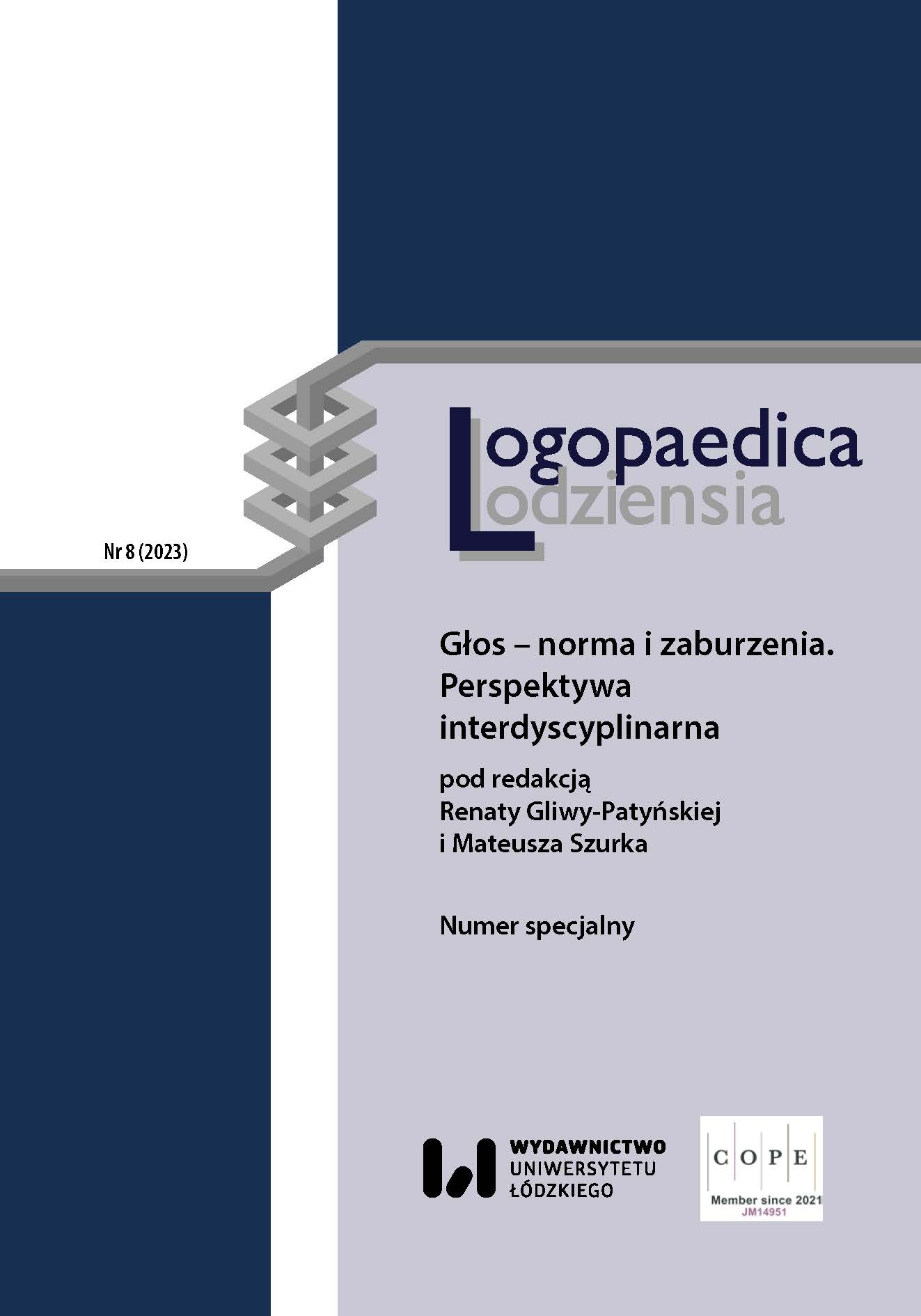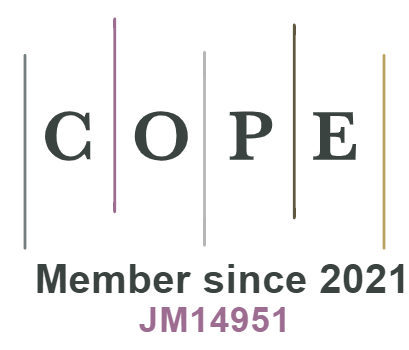Kwestionariusz Samooceny Głosu dla Transpłciowych Kobiet („Trans Woman Voice Questionnaire”) – polska adaptacja i walidacja
DOI:
https://doi.org/10.18778/2544-7238.08.04Słowa kluczowe:
TWVQ, feminizacja głosu, terapia głosu, transpłciowe kobiety, dysfonia płciowaAbstrakt
Kwestionariusz Samooceny Głosu dla Transpłciowych Kobiet (Trans Woman Voice Questionnaire – TWVQ) jest narzędziem diagnostycznym stworzonym specjalnie na potrzeby feminizującej terapii głosu. Uzupełnia on obiektywną diagnozę o subiektywne odczucia pacjentki. Terapeuta otrzymuje bezcenne informacje dotyczące jej potrzeb i oczekiwań, a sama pacjentka ma możliwość lepiej uświadomić sobie swój stosunek do własnego głosu. Kwestionariusz – zaprojektowany pierwotnie w języku angielskim – wymagał przełożenia na język polski. Proces tłumaczenia, a później adaptacji i walidacji został przeprowadzony zgodnie z rygorystycznymi wytycznymi Światowej Organizacji Zdrowia, w tym z udziałem transpłciowych pacjentek. Polska wersja TWVQ została zaakceptowana przez współautorkę oryginału i jest za darmo dostępna w internecie. Logopedzi i logopedki w Polsce otrzymali specjalistyczne narzędzie pomocne w terapii transpłciowych pacjentek.
Pobrania
Bibliografia
American Psychiatric Association, 2013, Diagnostic and statistical manual of mental disorders, Arlington: American Psychiatric Publishing.
Google Scholar
DOI: https://doi.org/10.1176/appi.books.9780890425596
Azul D., Neuschaefer‑Rube C., Nygren U., Södersten M., 2017, Transmasculine People’s Voice Function: A Review of the Currently Available Evidence, „Journal of Voice”, Vol. 31(2), s. 261.e9–261.e23.
Google Scholar
DOI: https://doi.org/10.1016/j.jvoice.2016.05.005
Bruin M.D. de, Coerts M.J., Greven A.J., 2000, Speech Therapy in the Management of Male‑to‑Female Transsexuals, „Folia Phoniatrica et Logopaedica”, Vol. 52, s. 220–227.
Google Scholar
DOI: https://doi.org/10.1159/000021537
Byrne L.A., 2007, My life as a woman: Placing communication within the social context of life for transsexual women, PhD thesis, La Trobe University, Melbourne.
Google Scholar
Dacakis G., Davies S., 2012, Trans Woman Voice Questionnaire, La Trobe University, Melbourne, University of British Columbia, Vancouver.
Google Scholar
Dacakis G., Oates J., Douglas J., 2012, Beyond voice: Perceptions of gender in male‑to‑female transsexuals, „Current Opinion in Otolaryngology and Head and Neck Surgery”, Vol. 20(3), s. 165–170.
Google Scholar
DOI: https://doi.org/10.1097/MOO.0b013e3283530f85
Dacakis G., Oates J., Douglas J., 2017, Associations between the Transsexual Voice Questionnaire (TVQMtF) and self‑report of voice femininity and acoustic voice measures, „International Journal of Language & Communication Disorders”, Vol. 52(6), s. 831–838.
Google Scholar
DOI: https://doi.org/10.1111/1460-6984.12319
Dacakis G., Davies S., Oates J., Douglas J., Johnston J., 2013, Development and Preliminary Evaluation of the Transsexual Voice Questionnaire for Male‑to‑Female Transsexuals, „Journal of Voice”, Vol. 27(3), s. 312–320.
Google Scholar
DOI: https://doi.org/10.1016/j.jvoice.2012.11.005
Grabias S., 2015, Postępowanie logopedyczne. Standardy terapii, [w:] S. Grabias, J. Panasiuk, T. Woźniak (red.), Logopedia. Standardy postępowania logopedycznego, Lublin: Wydawnictwo Uniwersytetu Marii Curie‑Skłodowskiej, s. 13–35.
Google Scholar
Grabski B., Mijas M., Dora M., Iniewicz G. (red.), 2020, Dysforia i niezgodność płciowa. Kompendium dla praktyków, Warszawa: Wydawnictwo Lekarskie PZWL.
Google Scholar
Hancock A., Colton L., Douglas F., 2014, Intonation and gender perception: Applications for transgender speakers, „Journal of Voice”, Vol. 28(2), s. 203–209.
Google Scholar
DOI: https://doi.org/10.1016/j.jvoice.2013.08.009
Jacobson B.H., Johnson A., Grywalski C., Silbergleit A., Jacobson G., Benninger M.S., 1997, The voice handicap index (VHI): development and validation, „American Journal of Speech Language Pathology”, Vol. 6(3), s. 66–70.
Google Scholar
DOI: https://doi.org/10.1044/1058-0360.0603.66
Leung Y., Oates J., Pang Chan S., 2018, Voice, Articulation and Prosody Contribute to Listener Perceptions of Speaker Gender: A Systematic Review and Meta‑Analysis, „Journal of Speech, Language, and Hearing Research”, Vol. 61(2), s. 266–297.
Google Scholar
DOI: https://doi.org/10.1044/2017_JSLHR-S-17-0067
Linde‑Usiekniewicz J. (red.), 2002, Wielki słownik angielsko‑polski PWN‑Oxford, Warszawa: Wydawnictwo Naukowe PWN.
Google Scholar
Neumann K., Welzel C., 2004, The importance of the voice in male‑to‑female transsexualism, „Journal of Voice”, Vol. 18(1), s. 153–167.
Google Scholar
DOI: https://doi.org/10.1016/S0892-1997(03)00084-5
Novais Valente Junior C., Mesquita de Medeiros A., 2022, Voice And Gender Incongruence: Relationship Between Vocal Self‑Perception And Mental Health Of Trans Women, „Journal of Voice”, Vol. 36, s. 739–882.
Google Scholar
DOI: https://doi.org/10.1016/j.jvoice.2020.10.002
Oates J., Dacakis G., 1997, Voice change in transsexuals, „Venereology”, Vol. 10(3), s. 178–187.
Google Scholar
Rawa‑Kochanowska A., 2011, Poczucie tożsamości płciowej w teorii i badaniach, Warszawa: Wydawnictwo Difin.
Google Scholar
Stempień J., 2021, Standard postępowania logopedycznego w przypadku osób transpłciowych przechodzących tranzycję, praca dyplomowa na Pomagisterskim Studium Logopedycznym Uniwersytetu Warszawskiego, Warszawa.
Google Scholar
Światowe Stowarzyszenie Specjalistów(‑tek) do spraw Zdrowia Osób Transpłciowych (WPATH), 2022, Standardy opieki zdrowotnej dla osób transseksualnych, transpłciowych i różnorodnych płciowo (wersja ósma), https://www.wpath.org/soc8 (dostęp: 15.01.2023).
Google Scholar
World Health Organization, 2019, ICD–11. International Classification of Diseases 11th Revision. The global standard for diagnostic health information, https://icd.who.int (dostęp: 15.01.2023).
Google Scholar
Pobrania
Opublikowane
Jak cytować
Numer
Dział
Licencja

Utwór dostępny jest na licencji Creative Commons Uznanie autorstwa – Użycie niekomercyjne – Bez utworów zależnych 4.0 Międzynarodowe.












